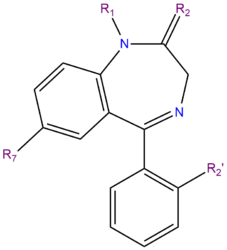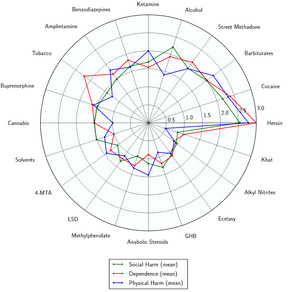Benzodiazepines: Difference between revisions
>Josikins m Text replacement - "prolific inhibitory receptor within the brain" to "prolific inhibitory receptor set within the brain" |
>Kaylee No edit summary |
||
| Line 1: | Line 1: | ||
{{DepressantOD|benzodiazepines}} | {{DepressantOD|benzodiazepines}} | ||
[[File: | [[File:Benzodiazepine1.png|227px|thumb|right|The core structure of benzodiazepines]] | ||
[[File:Xanax 2 mg.jpg|200px|thumbnail|[[Xanax]] ([[alprazolam]]) 2 mg tri-score tablets]] | [[File:Xanax 2 mg.jpg|200px|thumbnail|[[Xanax]] ([[alprazolam]]) 2 mg tri-score tablets]] | ||
'''Benzodiazepines''' (also referred to as '''benzos''') are psychoactive drugs that act as central nervous system [[depressants]]. These drugs work by magnifying the efficiency and effects of the neurotransmitter gamma aminobutyric acid ([[GABA]]) by acting on its receptors.<ref>Benzodiazepine interactions with GABA receptors | http://www.ncbi.nlm.nih.gov/pubmed/6147796</ref> The prominent effects of benzodiazepines include [[anxiety suppression]], [[sedation]], [[muscle relaxation]], [[disinhibition]], and [[amnesia]]. Short-acting benzodiazepines are recommended for treating insomnia while long-acting ones are recommended for the treatment of anxiety disorders. | '''Benzodiazepines''' (also referred to as '''benzos''') are psychoactive drugs that act as central nervous system [[depressants]]. These drugs work by magnifying the efficiency and effects of the neurotransmitter gamma aminobutyric acid ([[GABA]]) by acting on its receptors.<ref>Benzodiazepine interactions with GABA receptors | http://www.ncbi.nlm.nih.gov/pubmed/6147796</ref> The prominent effects of benzodiazepines include [[anxiety suppression]], [[sedation]], [[muscle relaxation]], [[disinhibition]], and [[amnesia]]. Short-acting benzodiazepines are recommended for treating insomnia while long-acting ones are recommended for the treatment of anxiety disorders. | ||
Revision as of 19:13, 18 May 2016

Fatal overdose may occur when benzodiazepines are combined with other depressants such as opiates, barbiturates, gabapentinoids, thienodiazepines, alcohol or other GABAergic substances.[1]
It is strongly discouraged to combine these substances, particularly in common to heavy doses.


Benzodiazepines (also referred to as benzos) are psychoactive drugs that act as central nervous system depressants. These drugs work by magnifying the efficiency and effects of the neurotransmitter gamma aminobutyric acid (GABA) by acting on its receptors.[2] The prominent effects of benzodiazepines include anxiety suppression, sedation, muscle relaxation, disinhibition, and amnesia. Short-acting benzodiazepines are recommended for treating insomnia while long-acting ones are recommended for the treatment of anxiety disorders.
It's worth noting that withdrawal from extended benzodiazepine use can result in hypertension, seizures, and death.[3] When suspending long-term use, it is highly recommended to taper one's dose by gradually lowering the amount taken each day for a prolonged period of time instead of stopping abruptly.[4]
Chemistry
 |
This chemistry section is incomplete. You can help by adding to it. |
Benzodiazepine is a heterocyclic compound comprised of a benzene ring fused to a diazepine ring. Benzodiazepine drugs are substituted 1,4-benzodiazepines with different side groups attached to the central structure.
Pharmacology
Benzodiazepines produce a variety of effects by binding to the benzodiazepine receptor site and magnifying the efficiency and effects of the neurotransmitter gamma aminobutyric acid (GABA) by acting on its receptors.[5] As this site is the most prolific inhibitory receptor set within the brain, its modulation results in the sedating (or calming effects) of benzodiazepines on the nervous system.
The anticonvulsant properties of benzodiazepines may be, in part or entirely, due to binding to voltage-dependent sodium channels rather than benzodiazepine receptors.[6]
Subjective effects
The effects listed below are based upon the subjective effects index and personal experiences of PsychonautWiki contributors. The listed effects will rarely (if ever) occur all at once, but heavier dosages will increase the chances and are more likely to induce a full range of effects. These effects are listed and defined in detail within their own dedicated articles below:
Physical effects
Paradoxical effects
|
Cognitive effects
|
Pharmacological classes
Equivalent dosages
The dosages below represent approximate equivalent dosages between various benzodiazepines in comparison to 40mg of diazepam.
The authors of this table specifically state that their equivalents differ from those used by other authors and "are firmly based on clinical experience during switch-over to diazepam at start of withdrawal programs but may vary between individuals." [11]
|
|
|
Toxicity and harm potential

Benzodiazepines have a low toxicity relative to dose.[13] However, they are [[Toxicity::potentially lethal when mixed with depressants like alcohol or opioids]].
It is strongly recommended that one use harm reduction practices when using this class of compounds.
Tolerance and addiction potential
Benzodiazepines are extremely physically and psychologically addictive.
Tolerance will develop to the sedative-hypnotic effects within a couple of days of continuous use.[14] After cessation, the tolerance returns to baseline in 7-14 days. Withdrawal symptoms or rebound symptoms may occur after ceasing one's usage abruptly following a few weeks or longer of steady dosing, and may necessitate a gradual dose reduction.[15] [16]
Discontinuation
Benzodiazepine discontinuation is notoriously difficult; it is potentially life-threatening for individuals using regularly to discontinue use without tapering their dose over a period of weeks. There is also an increased risk of hypertension, seizures, and death.[17] Drugs which lower the seizure threshold such as tramadol should be avoided during withdrawal.
It is safest to reduce the dose each day by a very small amount, for a couple of weeks until close to abstinence. If using a short half-life benzodiazepine, a longer acting variety such as diazepam can be substituted. Symptoms may still be present, but their severity will be reduced significantly. For more information on tapering from benzodiazepines in a controlled manner, please see this guide. Small amounts of ethanol can also help to reduce the symptoms.
The duration and severity of withdrawal symptoms depends on a number of factors including the half-life of the drug used, tolerance and the duration of abuse. Major symptoms will usually start within just a few days after discontinuation and persist for around a week for shorter lasting benzodiazepines. Benzodiazepines with longer half-lives will exhibit withdrawal symptoms with a slow onset and extended duration.
See also
External links
- Benzodiazepines (Wikipedia)
- Benzodiazepines (Drugs.com)
- Understanding Benzodiazepines by Steven M. Juergens MD
References
- ↑ Risks of Combining Depressants - TripSit
- ↑ Benzodiazepine interactions with GABA receptors | http://www.ncbi.nlm.nih.gov/pubmed/6147796
- ↑ A fatal case of benzodiazepine withdrawal. | http://www.ncbi.nlm.nih.gov/pubmed/19465812
- ↑ Canadian Guideline for Safe and Effective Use of Opioids for Chronic Non-Cancer Pain - Appendix B-6: Benzodiazepine Tapering | http://nationalpaincentre.mcmaster.ca/opioid/cgop_b_app_b06.html
- ↑ Benzodiazepine interactions with GABA receptors | http://www.ncbi.nlm.nih.gov/pubmed/6147796
- ↑ Benzodiazepines, but not beta carbolines, limit high frequency repetitive firing of action potentials of spinal cord neurons in cell culture. | http://www.ncbi.nlm.nih.gov/pubmed/2450203
- ↑ http://www.ncbi.nlm.nih.gov/pubmed/18922233 | Saïas T, Gallarda T | Paradoxical aggressive reactions to benzodiazepine use: a review
- ↑ Paton C | Benzodiazepines and disinhibition: a review | Psychiatr Bull R Coll Psychiatr | http://pb.rcpsych.org/cgi/reprint/26/12/460.pdf
- ↑ Bond AJ | Drug-induced behavioural disinhibition: incidence, mechanisms and therapeutic implications | CNS Drugs
- ↑ Drummer OH | Benzodiazepines—effects on human performance and behavior | Forensic Sci Rev
- ↑ BENZODIAZEPINE EQUIVALENCE TABLE | http://www.benzo.org.uk/bzequiv.htm
- ↑ Development of a rational scale to assess the harm of drugs of potential misuse | http://www.sciencedirect.com/science/article/pii/S0140673607604644
- ↑ Benzodiazepine metabolism: an analytical perspective | http://www.ncbi.nlm.nih.gov/pubmed/18855614
- ↑ Principles and Practice of Psychopharmacotherapy | http://books.google.com/books?id=_ePK9wwcQUMC&pg=PA535
- ↑ Clinical Pharmacology, Clinical Efficacy, and Behavioral Toxicity of Alprazolam: A Review of the Literature | http://onlinelibrary.wiley.com/doi/10.1111/j.1527-3458.2004.tb00003.x/pdf
- ↑ The American Psychiatric Publishing Textbook of Substance Abuse Treatment | http://books.google.com/books?id=6wdJgejlQzYC&pg=PA222&hl=en#v=onepage&q&f=false
- ↑ A fatal case of benzodiazepine withdrawal. | http://www.ncbi.nlm.nih.gov/pubmed/19465812


